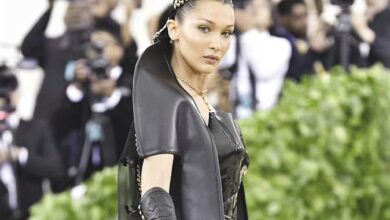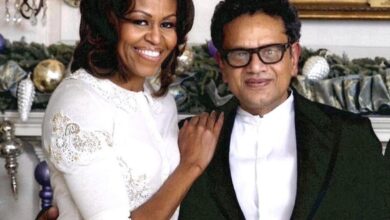Known for his simple yet daring designs, Egyptian fashion designer Mohamed Dagher is the talent behind the spectacular dresses worn by some of the Arab world’s best-known female celebrities, including Moroccan singer Samira Saeed, Lebanese diva Haifa Wahabi and Egyptian actress May Ezz el-Din.
Winner of the Dear Guest Award for best clothing designer in 2009, Dagher spoke with Al-Masry Al-Youm about artistic inspiration, Egypt’s budding fashion industry and his eagerly anticipated 2010 spring collection.
Al-Masry Al-Youm: How did you first get in to the fashion industry?
Mohamed Dagher: It happened by mere coincidence. I asked Samira Saeed if I could design a dress for her, and she wore it for one of her concerts. The design was a great success. Afterwards, I decided to go academic, so I joined L’Academie de la Mode in France.
Al-Masry: Which is more important in your view, academics or talent?
Dagher: Talent is the backbone of academics. But at the same time, many designers depend solely on their talents–and they do just fine. A talented designer will have the necessary awareness and creativity to excel.
Al-Masry: How do you get an idea for a dress?
Dagher: Anything inspires me. Sometimes it’s the material, other times it’s the accessories–a broach or a belt. Another way of doing it is to put all my ideas on paper, and just take it from there.
Al-Masry: Did you ever have a particularly difficult time designing a dress?
Dagher: Ninety percent of the time, I know how the dress is going to end up. When I start drawing, I’m usually on an adrenaline rush to finish it and see how it’s going to look. If the process becomes complicated half way through, I simply abandon it. My designs are all about simplicity and practicality.
Al-Masry: Do you have a favorite dress?
Dagher: All my designs are special to me, but the dress worn by actress May Ezz el-Din in my video clip is one of my favorites. It’s a simple gown with a butterfly design on the corsage.
The same pretty actress wore one of my designs in the movie "Omar and Salma." The producers needed to shoot a scene in three hours, so I had to come up with something creative but not time consuming. Finally, I came up with the idea of writing ‘I Love U’ on the dress with paint. I was pleasantly surprised to learn later that the robe had been a success and received astounding reviews.
Al-Masry: Who are your favorite fashion designers?
Dagher: I like Roberto Cavalli, Zuhair Murad and Elie Saab. Saab’s designs, in particular, are simple and creative.
Al-Masry: You’re famous for your draping technique. Can you tell us more about this?
Dagher: Draping is a well-known technique by which the designer pins cloth to the mannequin to get a preview of how the design will look. But I do it on real people. I actually have a client who comes an hour before her event to have her dress draped around her body.
Al-Masry: Do you ever have conflicts with any of your clients?
Dagher: I’m a designer, not an executer–and clients know that when they come to me. Therefore, I choose the design, the color and the material. If the client interferes more than is acceptable, I usually stop dealing with her–or I end up with a design that I absolutely hate.
Al-Masry: Many women don’t understand how to dress for their body shape. Do you have any tips?
Dagher: There are no exact rules that women should abide by. I believe each body has its own chemistry, and what suits you might look horribly unflattering on a person of your same shape, height and measures.
However, there are some general concepts that every woman should be aware of. Well-endowed women should avoid revealing décolleté and go for v-necks instead. Women with big hips should go for tops or blouses that reach the middle of their butts to lessen the curvature. I also recommend curvy and graceful designs for women with no waist.
Al-Masry: Does the environment in Egypt encourage fashion design?
Dagher: No not at all. The media doesn’t see us. There are entire economies built around the fashion industry, as in Paris and Italy. But in Egypt, all we care about is football. The government needs to nurture new talent, establish contact with and host foreign designers and build fashion schools.
Al-Masry: Given your background in music, have you considered a career in singing?
Dagher: I graduated from the conservatoire. I am a vocalist and a pianist. My first video clip was an advertising tool to promote my designs and boost my exposure. I’m currently working on a new song written by Ayman Bahgat Amar, which we’ll start shooting in two weeks.




